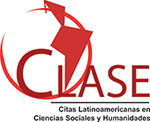Reciprocal Learning for listening comprehension
DOI:
https://doi.org/10.23857/dc.v7i1.1759Palabras clave:
Reciprocal learning, listening comprehension, skills, english language.Resumen
Reciprocal learning involves the interaction of students while working with their peers. Thus, it is the objective of this article to present the advantages and implications of reciprocal learning applied to listening comprehension. In addition, it presents the application Liu and Bu´s study, applied to our context. Methodologically, a bibliographic review was carried out, delving into previous studies carried out on the subject and the importance of listening for the acquisition of other communication skills such as writing, reading and speaking. Finally, it is concluded that there is a gap in the research that involves listening comprehension and that reciprocal learning has very broad advantages.
Citas
Ballinger, S. (2013). Towards a cross-linguistic pedagogy: Biliteracy and reciprocal learning strategies in French immersion. Journal of Immersion and Content-Based Language Education, 1(1), 131-148. doi 10.1075/jicb.1.1.06bal
Baxter, M. (1999). Creating contexts for learning and self-authorship. Nashville: Vanderbilt University Press.
Brown, A. & Campione, J. (1998). Designing a community of young learners: Theoretical and practical lessons. Washington: American Psychological Association.
Celce-Murcia, M. (1995). Teaching English as a second or foreign language (2nd ed). Boston: Heinle & Heinle.
Cope, B. & Kalantzis, M. (2012). Literacies. London: Cambridge University Press.
Council of Europe. (2020). Common European Framework of Reference and Assessment. https://www.coe.int/en/web/common-european-framework-reference-languages/assessment-in-the-classroom
Dehham, S., Hasan, A., & Raheem, M. (2018). The impact of reciprocal listening activities on fifth preparatory students’ listening comprehension. University of Babylon. https://www.researchgate.net/publication/329389359_The_Impact_of_Reciprocal_Listening_Activities_on_Fifth_Preparatory_Students'_Listening_Comprehension
Ghorbani, M., Gangeraj, A., & Alavi, S. (2013). Reciprocal teaching of comprehension strategies improves EFL learner’s writing ability. Current Issues in Education, 16(1), 1-12. https://www.researchgate.net/publication/286408693_Reciprocal_teaching_of_comprehension_strategies_improves_EFL_learners'_writing_ability
Graham, S. (2006). Listening comprehension: The learners’ perspective. System, 34(2), 165-182. http://www.sciencedirect.com/science/article/pii/S0346251X06000273
Heredia, M. (2018). Improving listening comprehension by using practical techniques in the third and fourth English levels. Kronos, 1(1), 61-74. http://revistadigital.uce.edu.ec/index.php/KronosJournal
Leykum, L., Palmer, R., Lanham, H., Jordan, M., McDaniel, R., Noel, P., & Parchman, M. (2011). Reciprocal learning and chronic care model implementation in primary care: Results from a new scale of learning in primary care. BMC Health Services Research, 11(44), 1-14. https://doi.org/10.1186/1472-6963-11-44
Liu, A. & Bu, Y. (2016). Reciprocal learning strategy in CALL environment: A case study of EFL teaching at X University in Shanghai. Universal Journal of Educational Research, 4(5), 1059-1070. https://files.eric.ed.gov/fulltext/EJ1099775.pdf
Mitnit, R., Recabarren, M., Nussbaum, M., & Soto, A. (2009). Collaborative robotic instruction: A graphs teaching experience. Computers & Education, 53(2), 330-342.
Mosston, M. & Ashworth, S. (2002). Teaching physical education (5th ed.). San Francisco: Benjamin Cummins.
Noel, P., Lanham, H., Palmer, R, Leykum, L., & Parchman, M. (2013). The importance of relational coordination and reciprocal learning for chronic illness care within primary care teams. Health Care Manage Rev., 38(1), 20-28. Doi: 10.1097/HMR.0b013e3182497262
Nowrouzi, S. (2015). Iranian EFL students’ listening comprehension problems. Theory and Practice in Language Studies, 5(2), 263-269.
Oxford, R. (1993). Language learning strategies: What every teacher should know. Boston: Heilen & Heilen
Ronald, K. & Roskelly, H. (1985). Listening as an act of composing. Retrieved December 17, 2020 from Eric Database No. ED 257094.
Saricoban, A. (1999). The teaching of listening. The Internet TESL Journal, December, 5 (12)
Sarani, A., Behtash, E., & Nezhad, S. (2014). The effect of video-based tasks in listening comprehension of Iranian pre-intermediate EFL learners. Gist Education and Learning Research Journal, 8, 29-47. https://files.eric.ed.gov/fulltext/EJ1062660.pdf
Sato, M. (2004). Pleasure of learning toward dialogic practice. Beijing: Education and Science Press.
Siegel, N. (2015). Exploring listening strategy instruction through action research. Palgrave: McMillan.
Schilling, D. (2002). Be an effective listener! Retrieved December 20, 2020 from http://www.Womensmedia.com/seminar-listening.htm
Terrell, D. Krashen, S. & (1984). The natural approach: Language acquisition in the classroom (5th ed). New York: Pergamon & Alemany.
Tomlinson, B. (Ed.). (2013). Developing materials for language teaching. London: Bloomsbury.
Vandergrift, L. & Goh, C. (2012). Teaching and learning second language listening: Metacognition in action. Routledge: Taylor & Francis Group.
Publicado
Cómo citar
Número
Sección
Licencia
Authors retain copyright and guarantee the Journal the right to be the first publication of the work. These are covered by a Creative Commons (CC BY-NC-ND 4.0) license that allows others to share the work with an acknowledgment of the work authorship and the initial publication in this journal.






